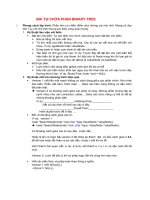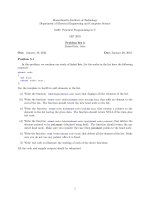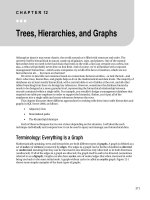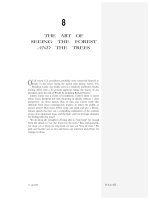Triumphant Tree
Bạn đang xem bản rút gọn của tài liệu. Xem và tải ngay bản đầy đủ của tài liệu tại đây (1.07 MB, 18 trang )
TRIUMPHANT
Brenda Hoddinott
D-09 BEGINNER: SQUIRKLING
With help from a simple grid, you sketch the outline of a
tree and use squirkles to shade in the texture of the
branches and trunk. Recommended for artists from age
09 to adult, as well as home schooling, academic and
recreational fine art educators
With help from a simple grid, you sketch the outline of a tree and use squirkles to shade in the
texture of the branches and trunk.
This lesson is divided into three parts:
SETTING UP YOUR DRAWING: You first choose and set up your drawing format with a
simple grid, and then sketch the outline of the tree’s branches and the rocky cliff.
OUTLINING DETAIL AND TEXTURE: You add more details to your outline of the cliff
and branches in preparation for shading.
SHADING REALISTIC TEXTURES: The textures of the tree branches, grass, tree trunk,
and the shrubbery are rendered with light, medium and dark squirkling values. You’ve
probably heard the old expression “A picture is worth a thousand words”. From this point
forward in this project there are very few written instructions. The step by step illustrations
show you what you need to draw.
Suggested drawing supplies include good quality white drawing paper, graphite pencils, kneaded
and vinyl erasers, and a ruler.
Recommended for artists, aged ten to ninety-nine, who have limited drawing skills, as well as
home schooling, academic and recreational fine art educators
18 PAGES – 24 ILLUSTRATIONS
Published by Hoddinott Fine Art Publishers, Halifax, NS, Canada (Revised 2006)
Copyright to all articles, images, text, projects, lessons and exercises within this drawing class belong to Brenda Hoddinott and may
not be reproduced or used for any commercial purposes whatsoever without the written permission of Brenda Hoddinott.
Web sites and
- 2 -
SETTING UP YOUR DRAWING
Before you draw the various textures of a rocky cliff and the branches and trunk of a tree, you
need to plan a place for everything, sort of like a blueprint. Texture is the surface detail of an
object, as defined in a drawing with various shading techniques. The senses of touch and sight
help identify the surface texture of drawing subject. Shading refers to the various shades of gray
(values) in a drawing that make drawings look three-dimensional.
In this section you first choose and set up your drawing format with a simple grid, and then
sketch the outline of the tree’s branches and the rocky cliff. Drawing format (sometimes called a
drawing space) refers to the area of a drawing surface within a specific perimeter, outlined by a
shape of any size, such as a square, rectangle or circle. A grid is a precise arrangement of a
specific number of squares, of exact sizes, proportionately drawn on a photo (or drawing) and a
drawing surface. Sketching is drawing a quick, rough representation or outline of a planned
drawing subject. A sketch can also be a completed work of art.
When you draw a human face, if your proportions are wrong, your drawing just won’t look
correct. Not so with a tree, if the proportions are off, it really doesn’t matter. Proportion is the
relationship in size of one component of a drawing to another or others.
Have a look at these three drawings of trees. Even though the proportions are different, they all
still look like trees. Some sizes to consider include:
Illustration 09-01: a square format 4 by 4 (or 6 by 6) inches (a short thick tree)
Illustration 09-02: a rectangular format 4 by 5 (or 6 by 7.5) inches (as used in this lesson)
Illustration 09-03: a rectangular format 4 by 7 (or 6 by 10.5) inches (a tall slender tree)
Feel free to draw your format any square or rectangular shape you prefer. Keep in mind that the
shape you choose will affect the shape of your tree.
ILLUSTRATION 09-03
ILLUSTRATION 09-02
ILLUSTRATION 09-01
Copyright to all articles, images, text, projects, lessons and exercises within this drawing class belong to Brenda Hoddinott and may
not be reproduced or used for any commercial purposes whatsoever without the written permission of Brenda Hoddinott.
Web sites and
- 3 -
1. Decide on a shape for your drawing format, and outline it on your drawing surface.
ILLUSTRATION 09-04
2. Draw a simple grid within your drawing
format.
Use a ruler to measure and find the center
point of each of each of the four sides of your
drawing format. Mark the center point on each
side with a small dot.
Divide your drawing format into four equal
sections by connecting your dots vertically
and horizontally.
3. Identify each of the four grid squares by
number.
You can simply keep their numbers in your
mind, or very lightly write numbers 1 to 4 in
the squares, as in Illustration 09-05.
ILLUSTRATION 09-05
In the following two steps, you draw
the cliff (from which the tree is
growing) within your drawing format
and. add the outlines of some small
shrubs and grass.
Illustration 09-05 shows what the
outline of the cliff looks like within a
4 by 5 inch format. If your format
isn’t this size, expect your drawing
to look a little different.
In illustrations 09-06 and 09-07, you
find close-ups of the two lower grid
sections, numbers 3 and 4, and
detailed instructions on how to draw
these two sections of the cliff.
1 2
3 4
Copyright to all articles, images, text, projects, lessons and exercises within this drawing class belong to Brenda Hoddinott and may
not be reproduced or used for any commercial purposes whatsoever without the written permission of Brenda Hoddinott.
Web sites and
- 4 -
4. Draw the section of the cliff in the lower left square (#3) of your drawing format.
Refer to Illustration 09-06. Focus on drawing only what you see inside this one rectangle
(or square, if that is the format shape you chose). Use the following guidelines:
Observe where the outline of the cliff touches the bottom side of your drawing format.
It is approximately one-third of the way across from the left lower corner. Mark this
point with a small dot.
Take note of where the outline of the cliff touches the right side of your format. It’s a
little more than two-thirds down the side. Mark this point with a small dot.
Begin with the dot on the bottom side and draw a curved line upwards and towards the
right.
When you get to the highest point, (above the second dot) begin drawing the outline
downwards and to the right.
Continue until your line connects with the dot on the right side of your format.
ILLUSTRATION 09-06
Copyright to all articles, images, text, projects, lessons and exercises within this drawing class belong to Brenda Hoddinott and may
not be reproduced or used for any commercial purposes whatsoever without the written permission of Brenda Hoddinott.
Web sites and
- 5 -
5. Draw a series of short lines to define the edge of the cliff on the right, as in grid square
#4 (the lower right square) in Illustration 09-07.
Use the following guidelines:
Observe how the series of short lines look like grass. The lines curve in many different
directions and some are short and others are longer. There are spaces between some and
in some places several lines are joined together.
Begin drawing where you left off at the dot you had marked on the right side of the
lower left square (# 3, to the left of this square).
Continue drawing lines toward the right and downward until you touch the left side of
this square.
ILLUSTRATION 09-07
Copyright to all articles, images, text, projects, lessons and exercises within this drawing class belong to Brenda Hoddinott and may
not be reproduced or used for any commercial purposes whatsoever without the written permission of Brenda Hoddinott.
Web sites and
- 6 -
In the following four steps, you outline the shapes of the clusters of branches of the tree in
preparation for shading. Shape refers to the outward outline of a form. Basic shapes include
circles, squares and triangles. Shading refers to the various shades of gray (values) in a drawing
that make drawings look three-dimensional. Drawing the shapes of the outlines exactly like mine
is not important. However, you should draw each cluster of branches in approximately the same
places and similar in size to mine.
6. Draw three clusters of branches (mostly inside grid square #4) in the lower right
section of the drawing format.
As you can see in Illustration 09-08, the clusters of branches are different shapes and sizes.
A tiny part of the largest branch extends over the center line and is in grid square #3.
ILLUSTRATION 09-08
Copyright to all articles, images, text, projects, lessons and exercises within this drawing class belong to Brenda Hoddinott and may
not be reproduced or used for any commercial purposes whatsoever without the written permission of Brenda Hoddinott.
Web sites and
- 7 -
7. Draw three more clusters of branches that are mostly in the upper right section of
your drawing format (grid square #2).
Refer to Illustration 09-09. Each of these clusters is similar in size, but their shapes are very
different. The more you vary the shapes of your branches, the more realistic your tree will
appear! Take note that tiny parts of each of them extends into adjourning sections of your
drawing format.
ILLUSTRATION 09-09









